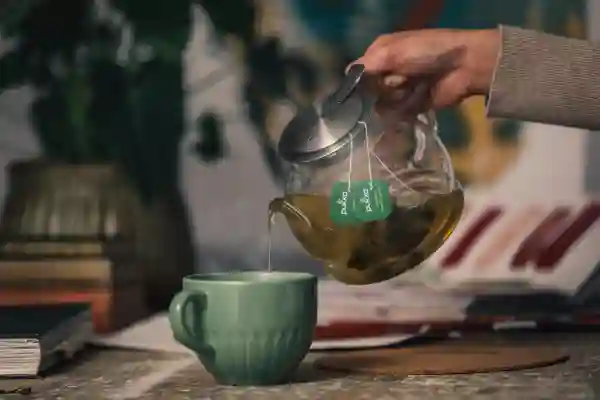

The amazing benefits of green tea
What is green tea?
Did you know tea is the most consumed beverage in the world after water? But it comes in many different forms such as green, black and white tea.
Green tea is made from the same plant (Camellia sinensis) as regular black tea and isn’t considered a type of herbal tea. The level to which tea leaves are ‘oxidised’ is the key differentiating factor between different types of tea from this one plant. Tea oxidation is the process that occurs when oxygen reacts with the enzymes in plucked tea leaves, causing them to turn brown and break down over time. Oxidation begins as soon as the tea leaves are plucked and is often accelerated by crushing or rolling the leaves. Black teas are left to fully oxidize but green tea skips this step, creating an unoxidized tea that keeps its beautiful green colour.
Green tea has been an important part of life in Chinese and other South Asian countries for the last 2000 years where it was used to increase concentration and focus. Indeed, the daily ritual of Buddhist monks infusing and serving green tea was part of a religious ceremony called ‘The Way of the Tea’. Indeed, there is a long history of green tea being used by monks to aid meditation as it helps be centred and focused. The traditional Japanese tea ceremony still centres on the preparation, serving and drinking of green tea as a ‘tea meditation’.
Why is green tea special?
Green tea’s popularity in the West is in part due to a good understanding of its health benefits. Research shows it contains various naturally occurring plant compounds that are associated with supporting health, reducing stress and increasing alertness. The keys ones are as follows:
L-theanine is an amino acid (building block of protein) found almost exclusively in tea. It is found almost exclusively in the tea plant and very closely resembles some neurotransmitters found in the brain. It has been shown to lower the cortisol response from stress and help us feel relaxed.
EGCG is another plant compound which helps to wake you up, get the brain working faster and stay focused.
Flavonoids are the pigments responsible for the diverse colours in fruits, vegetables and other plants including green tea, which have been shown to widely benefit brain and heart health.
Does green tea contains caffeine?
Along with black tea, green tea does contain caffeine, but in amounts lower than coffee. There are quite rightly concerns about limiting caffeine intake for health reasons as high amounts can lead to jitteriness as well as difficulty falling asleep. However, research shows small to moderate amounts can also lift mood. The caffeine in black, green and matcha tea is also balanced by the actions of L-theanine. This works with EGCG to balance the effect of caffeine and helps prevent the characteristic ‘crash’ associated with coffee. So green tea allows you to be dynamic whilst also developing a sense of calm alertness. Why not try this out for yourself with our ‘Power your Morning’ meditation, along with a cup of Supreme Matcha Green. You can sip the tea before, during and after your meditation, enjoying its warmth and aromas.
Why is green tea good for you? The health benefits of green tea include:
There has been a wealth of research looking at the wide health and wellbeing benefits of drinking green tea.
Green tea is a natural energy booster and supports a healthy metabolism.
Green tea helps us feel more alert, enhancing memory and concentration. It also helps counter the effects of stress through its L-theanine content.
Green tea contains powerful ‘polyphenols’, a type of plant compound which supports health such as by protecting against free radical damage. One 2021 study suggest that green tea’s polyphenol compounds might have a prebiotic effect, enhancing the health of our gut microbiome (1).
Beyond containing beneficial plant compounds, green tea is also considered as hydrating as water.
Our brains are made up of around 78% water and our bodies are around 55-60% water. We all need the right amount of water for many physiological processes, such as flushing out waste from the body, regulating body temperature and supporting brain function. Hydration is also key to maintaining a healthy immune and lymphatic system. Since green tea without milk or sugar consists of more than 99% water, it is considered to be an excellent source of hydration. As such, dietary guidelines in the UK as well as in several other countries such as Netherlands, China, Germany, Japan, and the US, suggest that unsweetened green and black tea can contribute to your daily fluid requirements.
Why not try our Clean Matcha Green tea to make a delicious cold brew drink?
Benefits of green tea for skin and hair
Beyond getting the benefits of green tea from drinking it each day, it can also be used for an array of skin and hair care uses. Hence green tea and its extracts are helpful for protecting against free radicals in the body that are not good for your skin and hair. These beauty applications for green tea have been well researched which is why you can find it as an ingredient in so many skin and hair products.
If you want to use something homemade, why not make your own hair rinse. Simply add 2 green tea bags to boiling water and allow them to infuse for 5 minutes. Once lukewarm, apply the liquid to your hair at the end of your shower. Wait for 10 minutes before rinsing it off with water. Do this twice a week for maximum effects.
Or you can use green tea at home to soothe tired eyes and give them some TLC. Make a cup of green tea for you and a friend. Then squeeze out the excess liquid from the green tea bags. Allow them to cool down so they’re still lukewarm or chill them in the refrigerator for 10 to 20 minutes. For general relaxation, the recommendation is to use them warm. For soothing irritated eyes use cool tea bags from the fridge. Apply the tea bags to closed eyes and relax for 15 to 30 minutes. It’s a great time to listen to some calming music, meditation or audiobook. A restorative yoga pose could help you relax from the stresses of your day while you’re doing your tea bag eye treatment.
Safety tips: Never use hot tea bags on the eye area, and remove contact lenses and eye makeup before doing the treatment.
How we grow our highest quality green tea
The terroir (growing environment) of the tea can be one of the most fundamental sources of a tea’s flavour. Just as a wine grape grown in Chile will taste different than the same type of grape grown in France, the character of a tea leaf can vary based on the location of the plant. Changes in climate, soil, or even surrounding vegetation can subtly change the leaf, and it’s resulting flavour.
Pukka green teas are the result of careful picking of the finest buds and leaves. Our tea partners know that the quality of the tea starts with the health of the soil and the ecosystem of the tea garden - soil fertility, plant growth and wildlife are all ecologically interconnected. A diverse and balanced presence of flora and fauna contributes to healthy tea bushes. Because they are 100% organic, artificial pesticides are not used, instead the ecosystem that is fostered provides habitats for predator insects to combat pests. The Indian Green tea used in Supreme Matcha Green, is sourced from the fair-trade Putharjhora Dooars estate in North-East India. This estate is set on a plain between two rivers and is home to a herd of local elephants as well as other rich biodiversity.
Carefully plucked from indigenous trees, some of which are thought to be well over 100 years old, the wild Pin Ho tea used in Supreme Matcha Green comes from the forests of Yen Bai Province in Vietnam. It is truly a unique type of green tea! In what is an excellent example of a sustainably managed ecosystem, the tea also brings economic benefits to the collectors, and requires no external inputs to the crop. The trees exist with many other tree species and wildflowers. Because the leaves are high up in the canopy, villagers can graze their livestock underneath. In this steep terrain, the tea trees also help to prevent soil erosion, with their deep roots holding firmly in place.
Try our range of green teas and discover your favourite. Taste the magic of green tea with uplifting ginseng, cool mint or refreshing lemon.
